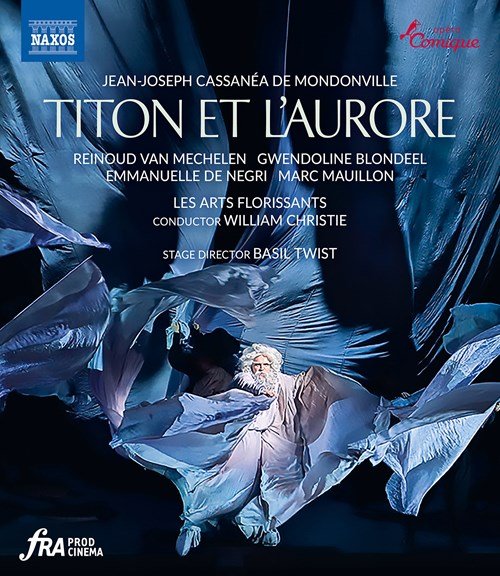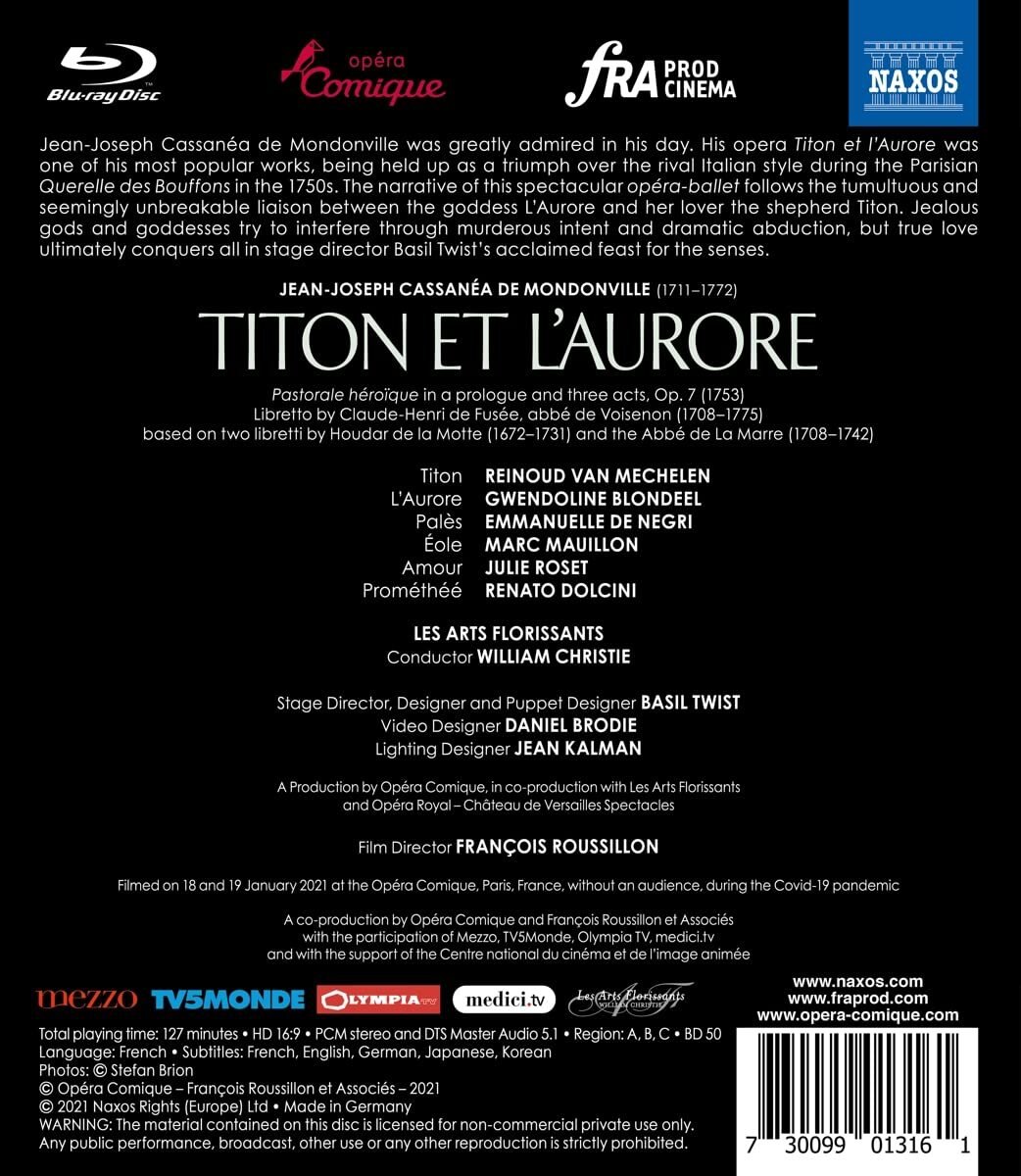

Jean-Joseph Cassanéa de Mondonville Titon et l’Aurore (Tithonus and Aurora) opera to a libretto by Claude-Henri de Fusée. Directed 2021 by Basil Twist at the Opéra Comique in Paris. Stars Reinoud Van Mechelen (Titon), Gwendoline Blondeel (L’Aurore), Emmanuelle de Negri (Palès), Marc Mauillon (Éole), Julie Roset (Amour), Renato Dolcini (Prométhéé) as well as Virginie Thomas, Maud Gnidzaz, and Juliette Perret (Nymphes). William Christie conducts Les Arts Florissants. Set and puppet design by Basil Twist; video design by Daniel Brodie; lighting design by Jean Kalman. Directed for TV by François Roussillon. Sung in French. Released 2021, disc has 5.1 dts-HD Master Audio sound. Grade: B+
When Italian singers in 1752 got a hit staging Pergolesi’s La serva padrona in Paris, the War of the Clowns broke out. The French counterattack was Mondonville’s Titon et l’Aurore. It premiered in Paris in 1753 (the year George Washington turned 21). The audience was mostly French soldiers. They packed the best seats to defend the local performers from partisans of Italian opera, who were forced into the upper galleries. Not to worry. Titon et l’Aurore remained genuinely popular for a decent run. That was 270 years ago. Before subject title was issued, there was exactly 1 discontinued CD set of the opera (a collectors’ item).
Almost half the disc chapters comprise the Prologue in which the gods Prometheus (a Titan) and Amore create civilization. The Prologue has nothing to do with the story of Titon and Aurore that follows. It was understood by all that Prologue was a reward for the patron who financed production of the show.
The story of Titon and Aurore might be the simplest show in all opera. It seems the human shepherd and the goddess of the dawn, Aurore, are in love. But the god of the wind, Éole, loved Aurore. The goddess of shepherds, Palès, loved Titon. So Éole and Palès contrived to break up the romance. Didn’t work. In revenge, Palès made Titon suddenly grow ancient in years. But Aurore appealed to Amour, who worked her magic to make Titon young again and immortal to boot! That’s all I want folks: to be 30 again and immortal!
The Mondonville music is serviceable and well played by Christie’s Les Arts Florissants. The singers are fine. The video file is as gorgeous as you would expect from TV director François Roussillon. But the remarkable thing about this title is the astonishing stagecraft of Basil Twist as designer, director, and puppet master. In a recent interview, Twist said, “The show is about love. It’s not heavy or edgy or hard. There’s a lot of joy, a lot of color and simple stagecraft. I want people to feel the good fortune we have to be able to create together.”
Most of Twist’s work could have been done centuries ago. But he also uses state-of-art video and lighting. His most distinctive mark is the use of huge billowing fabrics. In our first screenshot below we see Prometheus (Renato Dolcini ) creating civilization in the glow of a huge fire of undulating fabric illuminated by red and yellow lighting:
Prometheus is upstaged only by Amour (Julie Roset). They decide not to squabble but to work together on their new world:
Twist has the distinction of being the only American to graduate from the French École Nationale Supérieure des Arts de la Marionnette. We usually think of puppets as tiny figures created (with socks over hands or dangling from strings) to amuse children. But Twist’s puppets are life-size. They are manipulated by puppeteers (or even chorus singers) usually dressed in black and often hiding in shadows. Twist’s puppets sometimes engage in adult activities that might be get an “R” or “X” rating in a movie house:
Now we move from the Prologue to the opera about the shepherd Titon (Reinoud Van Mechelen) and the goddess Aurore (Gwendoline Blondeel) in love. Note the beautiful video in the background and the clever ring that focuses your attention on the singers and helps you ignore the puppeteers moving about in the background:
Somewhere I read that this show has 60 life-size sheep puppets!
Now we meet Éole (Marc Mauillon), the god of wind and storm. All the fabric flying around is controlled by puppeteers working in the shadows! Éole is in love with Aurore and is angry with Titon:
And here is Palès (Emmanuelle de Negri), the goddess of the shepherds. She is in love with Titon and is angry with Aurore. She always appears with two rams. The rams are not independent characters. They are part of Palès’s costume!
Éole and Palès agree to bust up the illicit love of the goddess Aurore and the human Titon:
Éole makes his move. But Aurore, faithful girl, rejects the god of storms:
All hurricane breaks loose, threatening the universe. The entire proscenium arch is filled with undulating clouds manufactured by a platoon of puppeteers. You can see some of the “billow artists” in the murky background. In an interview, Twist said he uses his puppeteers to make the singers “bigger, more fantastical.” They follow the singers around like a “little posse” to support and magnify their stage presence. The image below is now my favorite PC wallpaper of all time.
Palès is unhappy too. She throws poor Titon into dotage. But ever-faithful Aurore loves Titon so much, she prays to be retired as a goddess and allowed to join Titon in old age:
But wait, maybe Amore should be consulted! A sparkling sphere appears and soon . . . well, I don’t want to spoil this for you:
Here’s the finale, and this time there are also big dolls dangling from strings—what a riot of delight:
With William Christie, Basil Twist, and François Roussillon at work, a delightful product is guaranteed. Richard Lawrence calls this a “triumph” at page 72 of the March 2022 Gramophone. Other print writers knocked themselves out to avoid saying anything cruel.
But this is a silver cloud with the following dark lining: Titon et L’Aurore provides proof that an opera has to have a libretto. You know the drill: the libretto presents characters, the characters have a problem, there is suspense dealing with the problem, and, eventually, a resolution and denouement. Titon et L’Aurore doesn’t have this—it’s more like a pageant than a story. And that’s why you never heard of this opera before. Now to a grade. I start with A+ and drop back to B+ for the weak libretto. But if you are into stagecraft, you have to get this.
OR
















